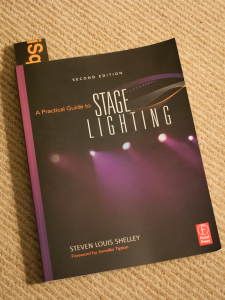Review: A Practical Guide to Stage Lighting, Second Edition
 Towards the end of 2009, Steve Shelley, noted lighting designer and drafting template guru, released the second edition to his book, A Practical Guide to Stage Lighting (published by Focal Press). Soon after the release of Mr. Shelley’s book, Focal Press was kind enough to send me a copy of the book to review.
Towards the end of 2009, Steve Shelley, noted lighting designer and drafting template guru, released the second edition to his book, A Practical Guide to Stage Lighting (published by Focal Press). Soon after the release of Mr. Shelley’s book, Focal Press was kind enough to send me a copy of the book to review.
Hands down this is a great book. I’ve personally met Mr. Shelley and he always has a smile on his face and a good story to tell, along with his trademark “lime green cap.” Though his vast lighting expertise is apparent, Mr. Shelley carries his wonderful sense of humor and storytelling throughout, making this edition both entertaining—and educational.
Layout of the Book
As an aspiring lighting designer, have you ever wondered what it’s like to design a Broadway-style show? Imagine being able to look over the shoulder of a professional lighting designer to see how he accomplishes his vision and design from start to finish. That is how Mr. Shelley has written the book. He first starts off with the basics of lighting: covering the layout of a theatre, stage directions, electricity, lighting instruments, and production staff. Why start there? The book assumes that this is your first venture into lighting and gives a quick overview of these topics to help you understand their use and role later on in the book.
After that, it’s all business. Beginning with the research of the show, first production meetings, organizing your paperwork, and of course, starting the design process—getting to “the hang,” focus, previews, opening night and finally, archiving all of your work. Mr. Shelley goes into great detail about each step of the process and provides some great insight and advice along the way with sidebars “Shelley’s Soapbox,” “Tales from the Road,” along with other helpful tidbits like “Shelley’s Notes,” “Sneaky Tips,” and my favorite, “Shelley’s Golden Rule.”and particularly in the “Shelley’s Soapbox” and “Tales from the Road” sidebars. Together, they give the readers a first hand glimpse into the real world of stage lighting.
Throughout the book, Mr. Shelley provides examples of his paperwork and drafting style to help the reader understand the subject matter at hand. This being the second edition of the book, Mr. Shelley has included over 60 new topics ranging from creating and negotiating contracts to working with other designers and production staff members through out the design process.
Targeted Audience
Mr. Shelley has packed his book with information and advice that anyone in the entertainment industry could use. But who did he write to book for? I believe that any aspiring lighting designer or technician will find this book quite useful. The book is not only a guide to help layout and design a show but it’s also a quick technical reference tool. Mr. Shelley mentions in the the introduction of the book that he himself uses his book time and time again to help remember important steps and processes in order to deliver a cost-effective, timely, and dazzling lighting design. Seasoned lighting design veterans can relate and use the book just as Mr. Shelley does. And, not only to help remember processes but to learn new and different methods as well.
Conclusion
For $49.95 from Focal Press’s website, (www.focalpress.com), Mr. Shelley’s latest edition of A Practical Guide to Stage Lighting is a must-read for new or up-and-coming lighting designers and technicians. Seasoned lighting designers will find Mr. Shelley’s book quite useful, as well, for learning different methods or refining their own design methods.
Thank you Mr. Shelley and Focal Press for providing me with a copy of A Practical Guide to Stage Lighting for this review.
[nggallery id=27]
LatestHeadlines
- Upgrading Your Toolbox: City Theatrical DMXcat-E and DMXcat Multi Function Test Tool
- Claypaky Bringing Back the Sexy to Par Cans with the Midi-B FX
- Ayrton Evolves the Cobra, the Cobra2 Developed for the US Market
- MA Lighting Intros grandMA3 onPC Fader Wing and DIN-Rail Nodes
- Live Events LEVL Up Fest: A Festival to Aid our Industry